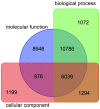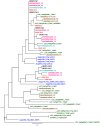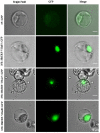Sequence and expression analyses of ethylene response factors highly expressed in latex cells from Hevea brasiliensis
- PMID: 24971876
- PMCID: PMC4074046
- DOI: 10.1371/journal.pone.0099367
Sequence and expression analyses of ethylene response factors highly expressed in latex cells from Hevea brasiliensis
Abstract
The AP2/ERF superfamily encodes transcription factors that play a key role in plant development and responses to abiotic and biotic stress. In Hevea brasiliensis, ERF genes have been identified by RNA sequencing. This study set out to validate the number of HbERF genes, and identify ERF genes involved in the regulation of latex cell metabolism. A comprehensive Hevea transcriptome was improved using additional RNA reads from reproductive tissues. Newly assembled contigs were annotated in the Gene Ontology database and were assigned to 3 main categories. The AP2/ERF superfamily is the third most represented compared with other transcription factor families. A comparison with genomic scaffolds led to an estimation of 114 AP2/ERF genes and 1 soloist in Hevea brasiliensis. Based on a phylogenetic analysis, functions were predicted for 26 HbERF genes. A relative transcript abundance analysis was performed by real-time RT-PCR in various tissues. Transcripts of ERFs from group I and VIII were very abundant in all tissues while those of group VII were highly accumulated in latex cells. Seven of the thirty-five ERF expression marker genes were highly expressed in latex. Subcellular localization and transactivation analyses suggested that HbERF-VII candidate genes encoded functional transcription factors.
Conflict of interest statement
Figures










Similar articles
-
Ethylene Response Factors Are Controlled by Multiple Harvesting Stresses in Hevea brasiliensis.PLoS One. 2015 Apr 23;10(4):e0123618. doi: 10.1371/journal.pone.0123618. eCollection 2015. PLoS One. 2015. PMID: 25906196 Free PMC article.
-
Identification of the Hevea brasiliensis AP2/ERF superfamily by RNA sequencing.BMC Genomics. 2013 Jan 16;14:30. doi: 10.1186/1471-2164-14-30. BMC Genomics. 2013. PMID: 23324139 Free PMC article.
-
Some ethylene biosynthesis and AP2/ERF genes reveal a specific pattern of expression during somatic embryogenesis in Hevea brasiliensis.BMC Plant Biol. 2012 Dec 26;12:244. doi: 10.1186/1471-2229-12-244. BMC Plant Biol. 2012. PMID: 23268714 Free PMC article.
-
Ethylene response factors regulate expression of HbSUT3, the sucrose influx carrier in laticifers of Hevea brasiliensis.Tree Physiol. 2021 Jul 5;41(7):1278-1288. doi: 10.1093/treephys/tpaa179. Tree Physiol. 2021. PMID: 33554256
-
Recent insights on gene expression studies on Hevea Brasiliensis fatal leaf fall diseases.Physiol Mol Biol Plants. 2022 Feb;28(2):471-484. doi: 10.1007/s12298-022-01145-z. Epub 2022 Feb 15. Physiol Mol Biol Plants. 2022. PMID: 35400887 Free PMC article. Review.
Cited by
-
Involvement of Ethylene in the Latex Metabolism and Tapping Panel Dryness of Hevea brasiliensis.Int J Mol Sci. 2015 Aug 4;16(8):17885-908. doi: 10.3390/ijms160817885. Int J Mol Sci. 2015. PMID: 26247941 Free PMC article.
-
Transcriptional and post-transcriptional regulation of the jasmonate signalling pathway in response to abiotic and harvesting stress in Hevea brasiliensis.BMC Plant Biol. 2014 Dec 2;14:341. doi: 10.1186/s12870-014-0341-0. BMC Plant Biol. 2014. PMID: 25443311 Free PMC article.
-
Ethylene Response Factors Are Controlled by Multiple Harvesting Stresses in Hevea brasiliensis.PLoS One. 2015 Apr 23;10(4):e0123618. doi: 10.1371/journal.pone.0123618. eCollection 2015. PLoS One. 2015. PMID: 25906196 Free PMC article.
-
Reactive oxygen species in Hevea brasiliensis latex and relevance to Tapping Panel Dryness.Tree Physiol. 2017 Feb 1;37(2):261-269. doi: 10.1093/treephys/tpw106. Tree Physiol. 2017. PMID: 27903918 Free PMC article.
-
Overexpression of Hevea brasiliensis ethylene response factor HbERF-IXc5 enhances growth and tolerance to abiotic stress and affects laticifer differentiation.Plant Biotechnol J. 2018 Jan;16(1):322-336. doi: 10.1111/pbi.12774. Epub 2017 Sep 2. Plant Biotechnol J. 2018. PMID: 28626940 Free PMC article.
References
-
- Latchman DS (1997) Transcription factors: An overview. The International Journal of Biochemistry & Cell Biology 29: 1305–1312. - PubMed
-
- Bleecker AB, Kende H (2000) Ethylene: a gaseous signal molecule in plants. Annu Rev Cell Dev Biol 16: 1–18. - PubMed
-
- Johnson PR, Ecker JR (1998) The ethylene gas signal transduction pathway: a molecular perspective. Annu Rev Genet 32: 227–254. - PubMed
-
- Pirrello J, Jaimes-Miranda F, Sanchez-Ballesta MT, Tournier B, Khalil-Ahmad Q, et al. (2006) Sl-ERF2, a tomato ethylene response factor involved in ethylene response and seed germination. Plant Cell Physiol 47: 1195–1205. - PubMed
-
- Dietz K-J, Vogel M, Viehhauser A (2010) AP2/EREBP transcription factors are part of gene regulatory networks and integrate metabolic, hormonal and environmental signals in stress acclimation and retrograde signalling. Protoplasma 245: 3–14. - PubMed
Publication types
MeSH terms
Substances
LinkOut - more resources
Full Text Sources
Other Literature Sources
Research Materials

